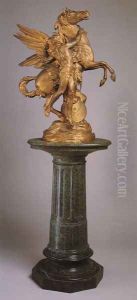Emile-Louis Picault Paintings
Émile-Louis Picault was a prolific French sculptor known primarily for his works depicting allegorical and mythological themes, as well as figures from French history. Born on August 24, 1833, in Paris, France, Picault was a prominent figure in the world of French sculpture during the latter half of the 19th century and the early 20th century. Over his long career, he produced more than 500 models, making him one of the most productive sculptors of his time.
Picault's works were characterized by a meticulous attention to detail and a strong emphasis on patriotic and philosophical themes. He studied under the tutelage of famous French sculptors and honed his skills in both the Ecole des Beaux-Arts and in private studios. Although not much is documented about his early life and training, it is evident through his works that he was deeply influenced by the Renaissance and the Neoclassical styles, which were predominant in the French art scene during his formative years.
Throughout his career, Émile-Louis Picault remained an independent artist, rarely participating in the official Salon competitions that were the stepping stones for many of his contemporaries. Despite this, his sculptures gained considerable popularity, and he was commissioned to create works for public spaces as well as for private collectors across France and abroad. His bronze sculptures, often featuring heroic, allegorical figures, are now highly sought after by collectors.
Notable among Picault’s oeuvre are his series of bronze statues celebrating the virtues of hard work, science, honor, and patriotism. His pieces were not only artistic expressions but also reflected the societal values and the surge of nationalism in France during the 19th century. His work 'Le Génie des Arts' (The Genius of Arts) is a prime example, showcasing his ability to imbue inanimate bronze with life and ideology.
Émile-Louis Picault passed away on August 24, 1915, leaving behind a legacy that has continued to be appreciated by art historians and collectors alike. His sculptures, which once graced the homes of the French bourgeoisie and public spaces, today adorn museums and private collections, standing as testaments to the enduring appeal of his artistic vision and craftsmanship.
